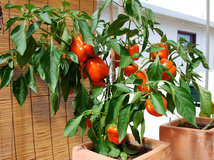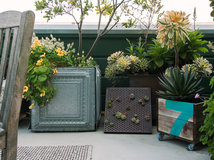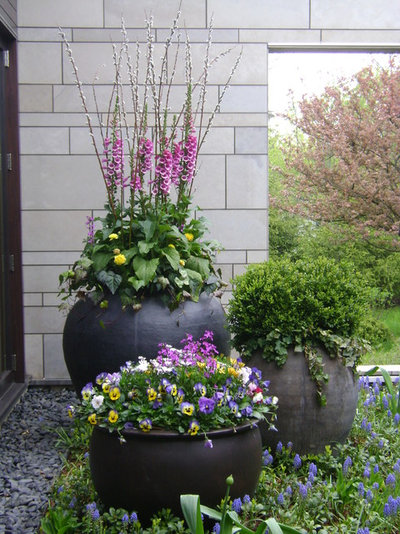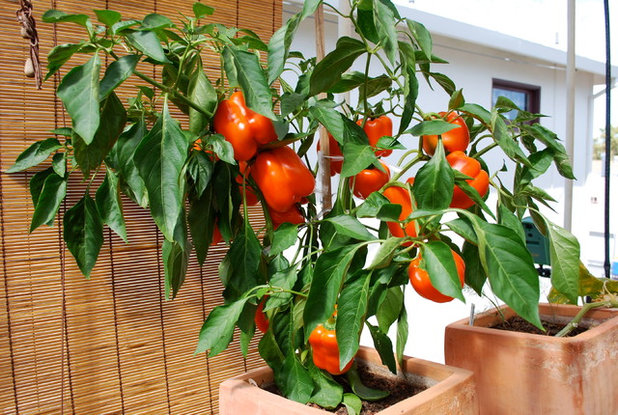Why Container Size Matters
A plant needs to be in a container that has enough room for it to grow but isn’t too big for the plant’s size. If a plant is in a pot that’s too small, its growth will be stunted, roots will become pot-bound and the soil will dry out quickly.
Conversely, a small plant potted up in a large container can be thrown off by the moisture balance in the soil. If plant roots can’t reach the bottom of the pot and drainage holes are at all obstructed, excess moisture will collect at the bottom of the container, forming a mass of soggy soil. This can lead to root rot, an extra-heavy container and a funky wet-soil smell.
A plant needs to be in a container that has enough room for it to grow but isn’t too big for the plant’s size. If a plant is in a pot that’s too small, its growth will be stunted, roots will become pot-bound and the soil will dry out quickly.
Conversely, a small plant potted up in a large container can be thrown off by the moisture balance in the soil. If plant roots can’t reach the bottom of the pot and drainage holes are at all obstructed, excess moisture will collect at the bottom of the container, forming a mass of soggy soil. This can lead to root rot, an extra-heavy container and a funky wet-soil smell.
What Size Container Do You Need?
Ornamental plants. How much soil a plant needs, and therefore how big a container it needs, depends on the type of plant and how deep the roots grow. For any container, keep soil quantity proportional to the plant type and size to help balance soil moisture.
Ornamental plants. How much soil a plant needs, and therefore how big a container it needs, depends on the type of plant and how deep the roots grow. For any container, keep soil quantity proportional to the plant type and size to help balance soil moisture.
- Small succulents need shallow soil (less than 6 inches).
- Annuals need a soil depth of 12 inches.
- Perennials need a soil depth of 12 to 18 inches.
- Shrubs need a soil depth of 18 inches to 2 feet.
- Small trees need a soil depth of 2 to 3 feet.
These dwarf blueberries can thrive in medium-size containers since the plants stay small.
Edible plants. For most plants grown as crops, the more room in a container you can give them, the better.
Edible plants. For most plants grown as crops, the more room in a container you can give them, the better.
- Herbs planted indoors can grow in soil that’s 6 inches deep; outdoors, plant them with a soil depth of 12 inches.
- Shallow-rooting crops like lettuces, strawberries and radishes can grow in 6 to 12 inches of soil.
- Medium-size edibles, including peppers, eggplants, squashes, melons and corn, require a soil depth of at least 12 to 18 inches.
- Give large-scale edible plants, such as tomatoes, potatoes and full-size berry shrubs, at least 18 inches or (better yet) 2 feet of soil.
- Citrus and other fruit trees need soil that’s 2 to 3 feet deep.
Container Shapes
Not only does a container’s size affect how well a plant grows, but the container’s shape does too.
Round, square and rectangular. Medium to large round, square and rectangular containers with deep soil reservoirs (12 inches to 3 feet, depending on the plant type) are good options for flowering perennials, shrubs and small trees. Use larger containers for planting combinations of multiple plants so each plant has room to grow.
See outdoor pots and planters
Not only does a container’s size affect how well a plant grows, but the container’s shape does too.
Round, square and rectangular. Medium to large round, square and rectangular containers with deep soil reservoirs (12 inches to 3 feet, depending on the plant type) are good options for flowering perennials, shrubs and small trees. Use larger containers for planting combinations of multiple plants so each plant has room to grow.
See outdoor pots and planters
Shallow. Low bowls with less than 6 inches of soil are perfect for growing small succulents like stonecrop (Sedum spp.) and hens-and-chicks (Sempervivum spp.).
Planting stands can raise low containers a little closer to eye level. Shallow containers also work well as toppers for outdoor side tables and dining tables.
Planting stands can raise low containers a little closer to eye level. Shallow containers also work well as toppers for outdoor side tables and dining tables.
Vase-shaped. Containers that flare out at the top are good options for mixed combinations of annuals, flowering perennials and an evergreen shrub or small tree.
The wide opening gives plenty of space to put together a combination of plants. Select the depth of the container based on which plant types you’d like to include.
The wide opening gives plenty of space to put together a combination of plants. Select the depth of the container based on which plant types you’d like to include.
Urn-shaped. Classical-style urns (wide at the bottom with a tight neck and wider opening) are good vessels for annuals and easily removed perennials. Keep in mind that if you plant anything that is deep-rooting, once a root ball forms below the neck of the urn, it can be tough to remove the plant.
If you’re thinking about something deep-rooting like a shrub, vine or small tree, plan to leave it there for its lifetime (size up on the urn at planting time).
If you’re thinking about something deep-rooting like a shrub, vine or small tree, plan to leave it there for its lifetime (size up on the urn at planting time).
Tall and upright. Tall, skinny containers can help elevate small plants, giving them more visual impact. Be careful about pairing a shallow-rooting plant like a succulent with a tall container (anything over 2 feet) filled with soil. It’s easy to overwater and have wet soil collect at the base of the pot beyond the plant roots.
This potted pair hits the sweet spot from a design and healthy soil perspective. The vertical shape of the containers elevates the plants, but the soil reservoir isn’t so deep that it would be at risk for becoming soggy.
This potted pair hits the sweet spot from a design and healthy soil perspective. The vertical shape of the containers elevates the plants, but the soil reservoir isn’t so deep that it would be at risk for becoming soggy.
Choosing Your Container
Given that a container’s size and shape affect how well a plant grows, it’s a good idea to choose plants and vessels at the same time. Otherwise, play matchmaker between containers you already have and the plants you intend to pot up.
When you’re choosing a container based on a plant, don’t rely on the plant’s initial size when estimating the size of container you will need. Instead, look up the mature size of the plant (often found on the back of the plant label) and which category it falls into (succulent, annual, perennial, shrub or tree). Be sure to choose a container that allows enough room for the plant to grow and a soil depth that will provide plenty of root space.
Given that a container’s size and shape affect how well a plant grows, it’s a good idea to choose plants and vessels at the same time. Otherwise, play matchmaker between containers you already have and the plants you intend to pot up.
When you’re choosing a container based on a plant, don’t rely on the plant’s initial size when estimating the size of container you will need. Instead, look up the mature size of the plant (often found on the back of the plant label) and which category it falls into (succulent, annual, perennial, shrub or tree). Be sure to choose a container that allows enough room for the plant to grow and a soil depth that will provide plenty of root space.
Special considerations for edibles. As previously mentioned, err on the side of giving more container space to any crops grown in containers. (Reference the list of ballpark soil depth per type of edible plant above). If crops like tomatoes, peppers, zucchini and eggplants are grown in a crowded container, they compete with one another for nutrients and sun exposure, which can lead to smaller harvests.
In general, it’s best to give each medium- or large-size edible plant its own container — possibly tucking herbs or pollinator-friendly plants like marigolds around the base if there’s excess room. Lettuces and smaller plants like radishes and strawberries can be planted multiple plants per container.
Container-grown edibles are big “feeders,” meaning they take a lot of soil nutrients to grow quickly and produce well. Fertilize with a well-balanced organic fertilizer according to package instructions.
Find out how to grow vegetables in containers
Container-grown edibles are big “feeders,” meaning they take a lot of soil nutrients to grow quickly and produce well. Fertilize with a well-balanced organic fertilizer according to package instructions.
Find out how to grow vegetables in containers
When to Repot
Plants aren’t happy if they’re left in a container they’ve outgrown. Here are three signs that container plants need repotting.
1. Plants look overgrown and are no longer proportional to the pot.
2. Water quickly runs out of the pot, indicating that roots, rather than water-absorbing soil, are taking up most of the space.
3. Plants show signs of stress, such as yellowing leaves, dieback or stunted growth.
Plants aren’t happy if they’re left in a container they’ve outgrown. Here are three signs that container plants need repotting.
1. Plants look overgrown and are no longer proportional to the pot.
2. Water quickly runs out of the pot, indicating that roots, rather than water-absorbing soil, are taking up most of the space.
3. Plants show signs of stress, such as yellowing leaves, dieback or stunted growth.
How to Repot
1. Choose a container that’s at least a few inches larger (width and depth) than the original container.
2. Remove plants from the old container by digging down 4 inches or deeper to loosen the roots and then gently tugging the plant free, using a hand trowel if needed for leverage. Keep as much of the root ball intact as possible.
3. Fill the new container with fresh potting soil and immediately plant transplants.
4. Water well, soaking the potting soil.
Alternatively, plant transplants out into garden beds rather than a new container.
1. Choose a container that’s at least a few inches larger (width and depth) than the original container.
2. Remove plants from the old container by digging down 4 inches or deeper to loosen the roots and then gently tugging the plant free, using a hand trowel if needed for leverage. Keep as much of the root ball intact as possible.
3. Fill the new container with fresh potting soil and immediately plant transplants.
4. Water well, soaking the potting soil.
Alternatively, plant transplants out into garden beds rather than a new container.
Exuberant displays of warm-season annuals and perennials can look as though they’ve outgrown their container by the end of the season, but it’s completely natural and doesn’t necessarily mean they need repotting. Flowers going to seed, dieback and yellowing leaves are just part of the life cycles of the plants.
Pull out annuals at the end of the season and cut back flowering perennials after frost. If the plants seem root-bound after one or two seasons, divide any remaining perennials and plant them in other containers or out into garden beds.
More
See more container gardening guides
Find a landscape professional on Houzz
Browse outdoor pots and planters
Pull out annuals at the end of the season and cut back flowering perennials after frost. If the plants seem root-bound after one or two seasons, divide any remaining perennials and plant them in other containers or out into garden beds.
More
See more container gardening guides
Find a landscape professional on Houzz
Browse outdoor pots and planters































































I have a Woolly bush in a large pot. I'm hoping it will adapt to pot life, so far so good. I have been able to control plant size with my Bay tree in a very large pot. If I'd put it in the ground, it would have been too large for the spot. Some species seem to be able to handle being 'stunted' without showing any obvious signs of distress. Thank you for the article, there is a heap of valuable information there.
Love all the suggestions of what to fill the base of large pots! And glad-wrap the pricklies - what a great idea!
Be careful if bringing terracotta pots inside that have been outside a while. You may have tom-cats in the area whose spray has been absorbed into the clay. You may not realise till your room has a strange smell and washing the pot may not eliminate it.